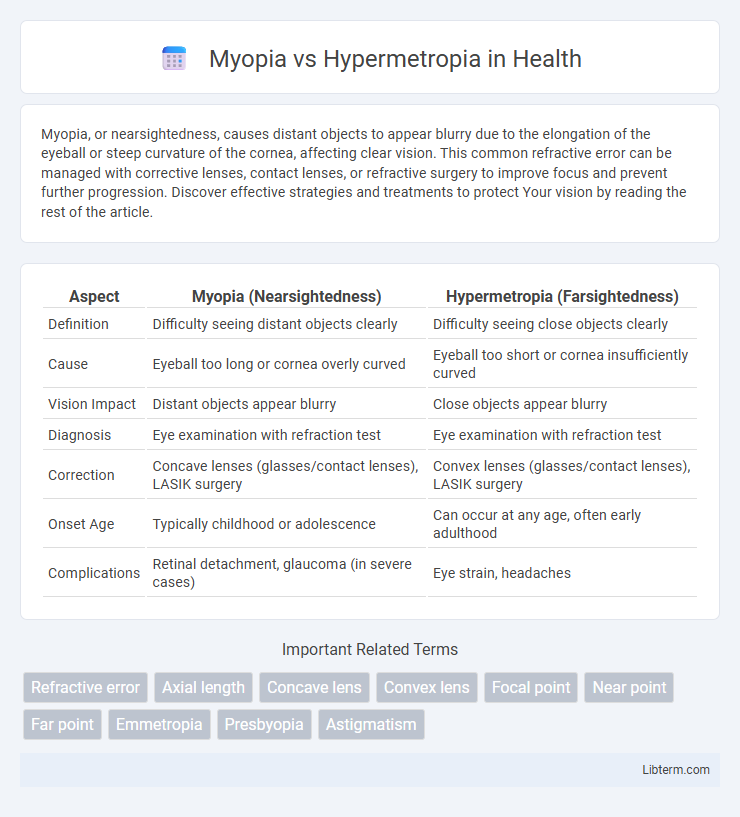Myopia, or nearsightedness, causes distant objects to appear blurry due to the elongation of the eyeball or steep curvature of the cornea, affecting clear vision. This common refractive error can be managed with corrective lenses, contact lenses, or refractive surgery to improve focus and prevent further progression. Discover effective strategies and treatments to protect Your vision by reading the rest of the article.
Table of Comparison
| Aspect | Myopia (Nearsightedness) | Hypermetropia (Farsightedness) |
|---|---|---|
| Definition | Difficulty seeing distant objects clearly | Difficulty seeing close objects clearly |
| Cause | Eyeball too long or cornea overly curved | Eyeball too short or cornea insufficiently curved |
| Vision Impact | Distant objects appear blurry | Close objects appear blurry |
| Diagnosis | Eye examination with refraction test | Eye examination with refraction test |
| Correction | Concave lenses (glasses/contact lenses), LASIK surgery | Convex lenses (glasses/contact lenses), LASIK surgery |
| Onset Age | Typically childhood or adolescence | Can occur at any age, often early adulthood |
| Complications | Retinal detachment, glaucoma (in severe cases) | Eye strain, headaches |
Understanding Myopia and Hypermetropia
Myopia, or nearsightedness, occurs when the eye's shape causes light to focus in front of the retina, leading to blurred distance vision, while hypermetropia, or farsightedness, results from light focusing behind the retina, causing difficulty seeing nearby objects clearly. These refractive errors stem from variations in the eyeball's length or corneal curvature, affecting the focal point of incoming light. Corrective lenses or refractive surgery adjust the focal point to the retina, improving clarity for both near and distant vision.
Key Differences Between Myopia and Hypermetropia
Myopia, also known as nearsightedness, causes distant objects to appear blurry due to the eye's elongation or corneal curvature, leading light to focus in front of the retina. Hypermetropia, or farsightedness, results in difficulty focusing on close objects because light focuses behind the retina, often caused by a shorter eyeball or a flatter cornea. Key differences include the focal point relative to the retina and the corresponding visual impairment: myopia affects distance vision, while hypermetropia primarily affects near vision.
Causes of Myopia
Myopia, caused primarily by the elongation of the eyeball or excessive curvature of the cornea, results in light focusing in front of the retina, leading to blurry distant vision. Hypermetropia occurs when the eyeball is too short or the cornea is insufficiently curved, causing light to focus behind the retina and difficulty focusing on close objects. Genetic factors, excessive near work, and insufficient outdoor activities significantly contribute to the development of myopia in children and adults.
Causes of Hypermetropia
Hypermetropia, or farsightedness, occurs when the eyeball is too short or the cornea has insufficient curvature, causing light to focus behind the retina rather than on it. Genetic factors and aging can contribute to the development of hypermetropia, as these affect the eye's shape and focusing ability. Unlike myopia, which results from an elongated eyeball, hypermetropia causes difficulty seeing nearby objects clearly.
Symptoms: Myopia vs Hypermetropia
Myopia causes blurry distance vision, headaches, and eye strain due to difficulty focusing on distant objects, while hypermetropia leads to blurred near vision, frequent eye fatigue, and squinting as the eyes struggle to focus on close tasks. Both conditions may result in headaches and eye discomfort, but the specific visual blur location--distance for myopia and near for hypermetropia--is a key distinguishing symptom. Early recognition of these symptoms can guide appropriate corrective measures like glasses or contact lenses tailored to distance or near vision correction.
Diagnosis: Eye Exams and Tests
Myopia is diagnosed through refraction tests and visual acuity assessments, revealing difficulty in seeing distant objects clearly, while hypermetropia is identified by assessing near vision clarity and refractive error. Comprehensive eye exams include retinoscopy and autorefractor measurements to quantify the degree of focusing errors. Pupil responses and slit-lamp examinations aid in ruling out other ocular conditions during diagnosis.
Treatment Options for Myopia
Myopia treatment options primarily include corrective lenses such as concave eyeglasses or contact lenses that help focus light correctly on the retina. Laser eye surgeries like LASIK and PRK are effective for reshaping the cornea to improve vision permanently. Orthokeratology lenses worn overnight temporarily reshape the cornea and can slow the progression of myopia in children and young adults.
Treatment Options for Hypermetropia
Hypermetropia treatment primarily involves the use of convex (plus) lenses in eyeglasses or contact lenses to converge light rays onto the retina, improving distant and near vision. Refractive surgery options such as LASIK or PRK can also correct hypermetropia by reshaping the cornea for better focus. In some cases, multifocal or bifocal lenses are prescribed to address both distance and close-up vision difficulties caused by hypermetropia.
Prevention and Eye Care Tips
Myopia can be managed by reducing prolonged near work and encouraging outdoor activities to slow progression, while hypermetropia requires regular eye exams to monitor changes and appropriate corrective lenses to prevent eye strain. Both conditions benefit from proper lighting during reading, maintaining an ergonomic posture, and taking frequent breaks following the 20-20-20 rule to reduce digital eye strain. Nutrient-rich diets with vitamins A, C, and E support overall eye health and may help delay the onset of refractive errors.
Myopia and Hypermetropia: Frequently Asked Questions
Myopia causes difficulty seeing distant objects clearly, while hypermetropia leads to blurred vision for nearby objects. Both conditions result from refractive errors where myopia involves elongation of the eyeball and hypermetropia involves a shorter eyeball or flattened cornea. Corrective lenses, such as concave lenses for myopia and convex lenses for hypermetropia, effectively improve vision by adjusting light focus onto the retina.
Myopia Infographic

 libterm.com
libterm.com